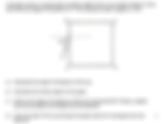320 results found with an empty search
- Distance-time and Speed-time graph of 2 objects in motion
The distance-time (displacement-time) graph on the left is not related to the speed-time (velocity-time) graph. Both are of difference scenarios. But both shows the motion of 2 objects and both graph has an interception point. Do the interceptions point mean the same time in each graph? The image below shows the basic interpretation of the respective graphs. To have examples of the graphs with values and the step-by-step how to find the time it overtakes, refer to the videos below. Finding the exact time where the overtaking takes place.
- Kinematics Basic Concepts
01 The various physical quantities in kinematic Video tutorial 02: Acceleration Video tutorial 03: Graphical Analysis of Motion (Displacement (distance)-Time Graph and Velocity (speed)-Time Graph) Video tutorial 04: Describing the motion of the car – practice Video tutorial
- Pressure – Height of ethanol in the column
Answer: Option D
- 2 pistons of different pressure joined together - P1V1 = P2V2
Solution: Option C
- Where is the focal point of lens L1 and L2?
Answer: Option A Refer to the diagram (below left) which many are familiar. When parallel rays of light which are parallel to the principal axis enter the lens, the rays bend (refraction), come closer and converge to a point on the principal axis called focal point (F) . The distance from the optical centre (C) to the focal point (F) is the focal length (f) . But what if the parallel rays of light entering the lens are not parallel to the principal axis but at an angle as shown on the diagram (below right)? As you can see, the rays refracted and converge to a point P which is along the focal plane (imaginary vertical line through F and is perpendicular to the principal axis). This is similar to L1 in the question. (Refer to the first section of the video simulation below to reinforce your concept) How about L2 in the question? Light is reversible so you can also treat the light rays entering from the right of the lens L2. The parallel rays of light in L2 are at an angle but there is no ray through the optical centre C. Refer to the video below, as you can see, the parallel rays of light will likewise refract and converge to a point, which is along the focal plane too. Hence the focal point of both lenses L1 and L2 is at F2. So the answer is Option A.
- Lens, screen and mirror – what kind of image formed on screen
Answer: Option C
- Total Internal Reflection (TIR) example 01
Solutions: a) Refraction b) 48.6o c) c = 41.8o e) 70o d) Total internal reflection has occured, as the angle of incidence is greater than critical angle and the light is traveling from a denser medium (glass) towards a less dense medium (air) Click on the video tutorial for explanation and working for part (a) and (b). Click on the video tutorial for explanation and working for part (c) to (e).
- Total Internal Reflection (TIR) example 02
Solutions: a) 38.8o b) 41.8o c) 51.2o . The ray does not emerge as total internal reflection has occurred. The angle of incidence is greater than critical angle and the light is traveling from a denser towards a less dense medium. Click here to view the video tutorial for working and explanation for (a) and (b). Click here to view the video tutorial for working and explanation for (c) and (d).
.png)











